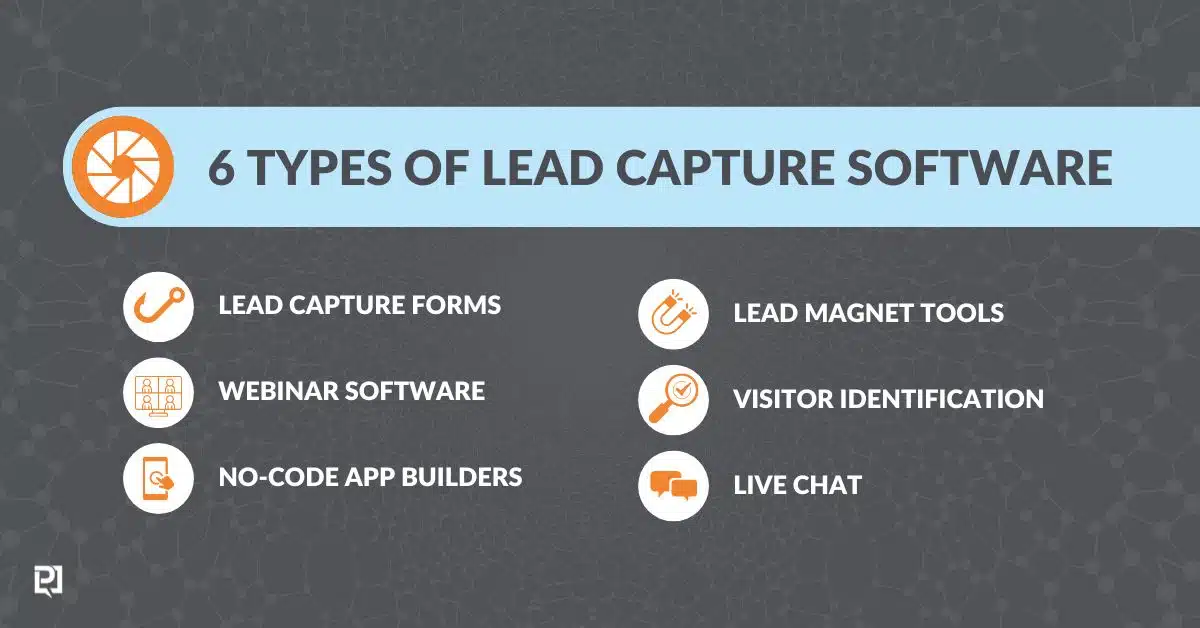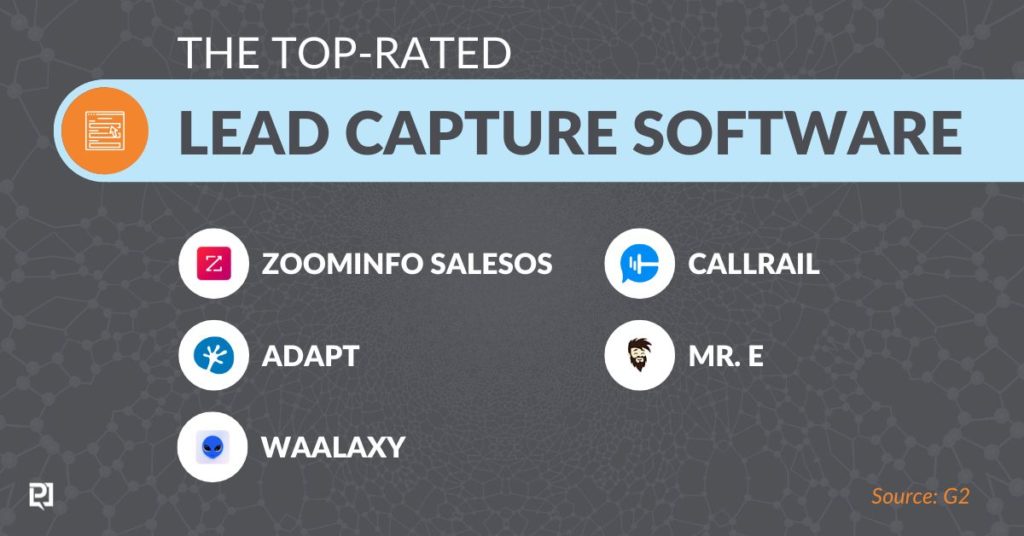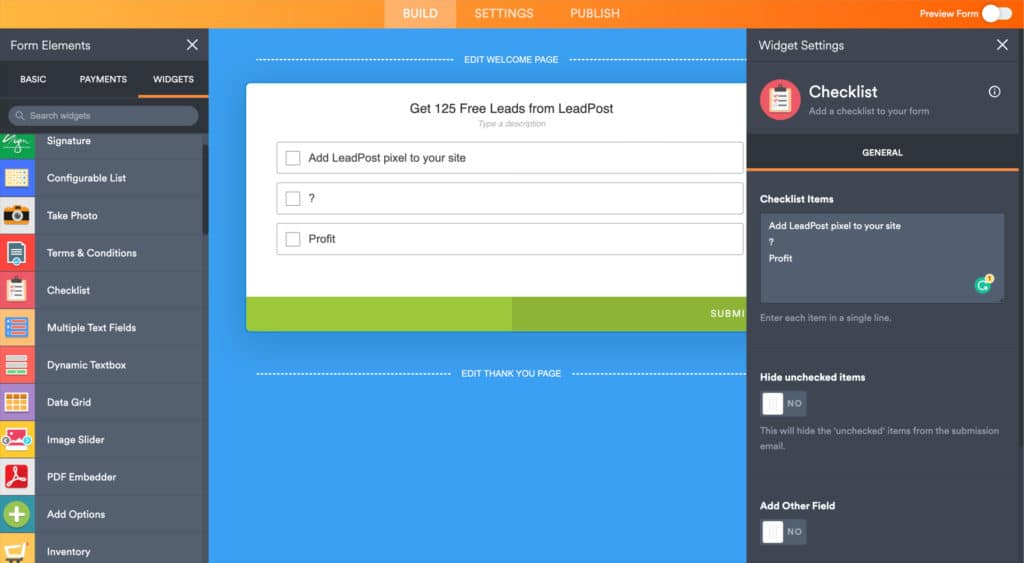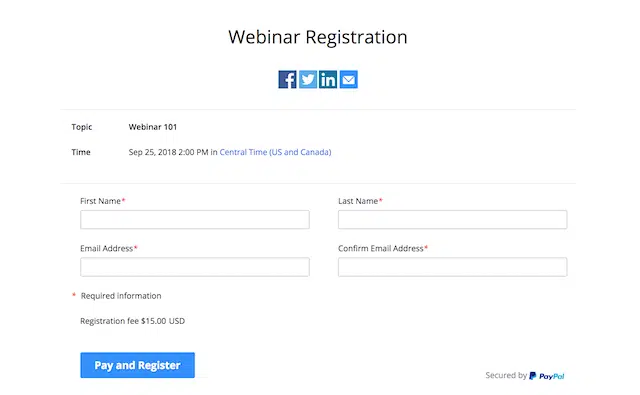If “lead capture software” makes you think of forms and popups, you’re missing out! Forms are obviously an important part of lead generation – they’re (usually) how you actually capture the lead, so that makes sense.
But just like there’s more than one way to skin a cat (if you’re into that sort of thing 🤨), there’s more than one way to capture a lead (focus on lead generation and leave the cats alone, please). In this article, we’ll cover your best options to keep your sales team happy with lead capture software.
Types of Lead Capture Software
We’ll cover six types of lead capture software.
- Website visitor identification tools
- Webinar software
- Live chat software
- Lead magnet builders
- Lead capture forms
- No-code app builders

The key features to look for in lead capture software are:
- Does it integrate with the lead generation tools, email marketing software, and other sales/marketing tools you use?
- Does it provide data you can’t get any other way?
- Does it provide a good customer experience for your prospects?
- Does it provide a good user experience for your sales and marketing teams?
The Benefits of Lead Capture Software
Lead capture software helps businesses improve the sales process by automating critical parts of lead generation, specifically, the process of collecting and storing information about potential customers, also known as leads.
This can include information such as contact details, demographics, and areas of interest. This information can then be used to personalize and streamline the sales process, allowing businesses to quickly identify and prioritize the most promising leads, and to target their sales efforts more effectively.
Good lead capture software solutions should integrate with your landing pages and email marketing tools to further streamline your lead generation and marketing efforts.
Additionally, lead capture software often includes tools for tracking and analyzing lead behavior, allowing businesses to gain insights into the effectiveness of their sales and marketing strategies, and to make data-driven decisions about how to improve them.
Lead Capture Forms
Most marketers probably just use the forms packaged with some of their other marketing tools or sales software. Email marketing platforms, marketing automation software, lead generation tools, and CRMs often come with some sort of landing page builders and form capabilities.
That’s usually enough to get the job done – as long as your tool integrates with whatever your sales team is using – but these options are usually not very robust.
For something a little better, try OptinMonster.
OptinMonster doesn’t just make things easier for sales teams. It helps marketing teams keep sales pipelines full as well.
It’s key features include standard issue lead collection tools like popups and inline forms, but it goes beyond that. For example, you can use conditional redirects to send people to different confirmation pages depending on factors like their answers to a field in the form.
And that’s just on the Basic Plan. The Growth Plan ($82/mo) includes coupon wheel campaigns, real-time personalization, geolocation targeting, and more.

Typeform is probably the most visually appealing way to collect leads, but it’s costly. It’s especially expensive if you want access to some of the more useful features. On the plus side, its forms look great on their own so you really don’t even need a landing page.
Jotform‘s forms look good too and has a similar feature set, but it’s more affordable and it’s priced based on usage, not features.

Webinars
Webinars are a good for lead generation because, if you do them right, they feel like high-value offerings and they give you a way to connect directly with prospects. Zoom is the popular choice, but according to G2 reviews, Wistia is the easiest to use.
Among all of Wistia’s key features, the most important one is that it has a slicker, more intuitive user interface. That said, webinar functionality is only available on its most expensive plans ($399/mo and up).

Zoom is cheaper, but its registration pages look really bad, but you can replace them with a landing page of your choice as long as your lead capture software integrates with Zoom.

For a more affordable option, check out Airmeet. It’s pretty pricy ($6,000/yr+) if you decide to upgrade to a paid plan, but they have a free version that will allow you to host 90-minute webinars for up to 50 people.

Live Chat
You can also collect leads through live chat software.
Live chat software provides a direct, immediate way for your website visitors to reach you.
It helps with the sales process and custom support, but it can also work as lead capture software.
How? Well, we’ve all seen those live chat tools that get us to ask a question and then require our email before we go further (just “in case we get disconnected” of course).

In addition to their ability to collect leads, live chat tools are effective because they allow you to provide personalized and responsive customer service, even outside of traditional business hours (whether through a chatbot or outsourced chat agents, which tawk.to offers for $1/hr).
Live chat software can be integrated with lead capture functionality so you can collect and store information about your website visitors.
This can include details such as their name, contact information, and areas of interest. Then, you can use that information to personalize your follow-up messages and prioritize leads based on their level of engagement or other qualifying factors.
Tawk.to is a full-featured option that you can use for free.
Lead Capturing Lead Magnets
Most people can’t think of lead generation without thinking about lead magnets. Lead magnets are the lure we use to get people to submit their contact information on a landing page, but it can be difficult to create digital products, tools, and experiences that are valuable to potential customers.
There are two marketing tools that not only make it easier to create lead magnets but also collect the leads for you.
Outgrow‘s key features make it easy to create interactive content like quizzes and calculators. And it has a built-in lead capture feature. So all you have to do is build a piece of content (from scratch or with one of their templates) and connect Outgrow to your CRM or marketing automation software.
You can also use Outgrow to power your sales process by developing questionnaire’s that help prospects determine which of your offerings is the best fit for their needs. And it can be used to make sure you’re sending qualified leads by collecting data on your prospects.
For more traditional lead magnets, Beacon is a tool that you can use to create eBooks, workbooks, email templates, resource libraries, and more.
![]()
Instead of uploading your lead magnets somewhere and setting up an automation workflow to deliver them, Beacon does all the work for you.

Website Visitor Identification
LeadPost turns your traffic into B2C or B2B leads automatically. It also includes an integrated retargeting platform so that you can trigger email, paid social, display, and direct mail campaigns to nurture your leads.
And you can set up filters so you don’t pay for conversions you would have gotten anyway. Just set up a send delay so that leads are only sent after a day or two. That will give them time to convert on their own.
Engineering as Marketing
Another alternative to using forms to collect leads is to create free tools that require users to submit their contact information. HubSpot’s Website Grader and Coschedule’s Headline Studio are two examples.
This is known as engineering as marketing, and you can read more about it in the book Traction (the one by DuckDuckGo CEO and founder Gabriel Weinberg, not Gino Wickman, creator of the Entrepreneurial Operating System).
You create tools that are relevant to your target market and the problems you solve. They use them and hopefully share them. By requiring users to submit their contact information in order to use the tool (something most people expect), you can then continue to nurture them as leads (albeit top-of-funnel leads who might not be ready to make a purchase in the near future).

You can create those kinds of mobile apps relatively easily with no-code app builders like Quickbase, Glide, Jotform Apps, and AppSheet from Google. Even though they don’t require coding, not all no-code app builders are easy to use. They’re not all affordable either. Some of them charge per user (as in per user of your app).
The key features to look for are ease-of-use and affordable pricing.
According to G2 reviews, Quixy is the easiest to use, but the lowest plan costs $3,600 a year. But JotForm Apps ranks as the second easiest to use, and it is much more affordable.
Take Capturing Leads to the Next Level
Leads aren’t leads until you capture them! So try the tools in this article and see which ones will help you turn more of your visitors into contacts in your CRM.
